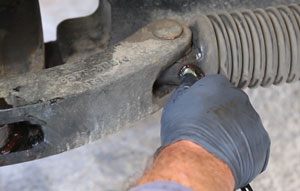The Importance of Proper & Frequent Forklift Greasing

Did you know every manufacturer recommends a weekly forklift greasing schedule to ensure the best performance? This means that whether you’re working in warehousing, construction, or gas & oil, it is crucial that your forklift is sufficiently greased on a regular basis. Proper greasing will reduce friction and grinding between components, prolonging the life of your equipment while reducing downtime and saving you money. A few minutes every week is all it takes, so make sure you have greasing added to your weekly schedule!
It can be difficult to know where all the grease points on a forklift are, so we’ve made a list outlining the location of each component. Though this list applies to most forklifts, your unit may differ in terms of location and ease of access for certain sections. Certain components may also be referred to by another name, or your unit may not have some of them. Consult your user manual for a reference guide. Before starting the greasing procedure, ensure that you chock the wheels to prevent the forklift from moving.
Forklift Greasing Component Checklist
- Left & right inner steer link.
- Left & right outer steer link.
- Left & right upper king pin.
- Left & right inner king pin.
- Steer-axle mount pivot pins (right & left).
- Front & rear U-joints.
- Slip yoke (located on the drive shaft).
- Front cab tilt pins & bushings
- Rear cab tilt pins & bushings.
- Upper side shift bushings (right & left).
- Upper carriage bearings (right & left).
- Outer tilt cylinder pins & bushings (right & left).
- Barrel-end tilt cylinder pins & bushings (right & left).
- Forks.
- Upper & lower fork bar.
- Trunnion pins & bearings.
- Lower carriage bearings.
- Lower mast bearings.
- Chain pulleys.
- Lift chains.
Make sure you wipe off any excess grease once you’re done with each component.
Once all these components have been greased, it’s time to move on to the Forks. Lubricate the Upper and Lower Fork Bar to reduce friction when transporting loads. Some forks have grease fittings at the top of the forks, so you’ll want to deposit the grease into these fittings instead. Once you have performed the first wave of greasing, move the forks from side to side (if your unit has a side-shift cylinder). This will ensure that there is a well-distributed coat of grease across the forks. A small painters brush is a good choice to spread the grease, but if you don’t have one on hand, you can just use the greaser itself to distribute it.
Now that these components have been greased, raise and lower the forks and move them from side to side. This spreads the grease and ensures a more even coating. Once the forks have been raised, you can access several components that were out of reach before. Please note: Whenever you are working under the forks of the machine, you must be using certified chains that are rated for the required load to hold the forks in place. Once the forks have been secured, we can move on to the Trunnion Pins & Bearings. These areas are often neglected, which can cause a lot of damage over time. You will often have to remove old grease to find the grease nipples underneath. With the forks raised, you’ll also be able to access the Lower Carriage and Lower Mast Bearings, so ensure that you grease both of these on each side.
Once these lower components have been greased, it’s time to move on to the Chain Pulleys at the top of the mast. You’ll also want to grease the Lift Chains themselves to greatly reduce the amount of friction on them, keeping wear and tear to a minimum. It is recommended to use a spray-based lubricant for the chains. While greasing them, we recommend holding a piece of cardboard behind the chain to block any excess spray from getting onto the windshield. Now that this has been done, give the machine one last inspection to ensure that you have greased all 20 of the components (on both sides) mentioned above.
By following this weekly greasing guide, you’ll reduce your downtime, improve performance, and save money on maintenance costs. This will ensure that you have a greatly enhanced experience with your equipment.

